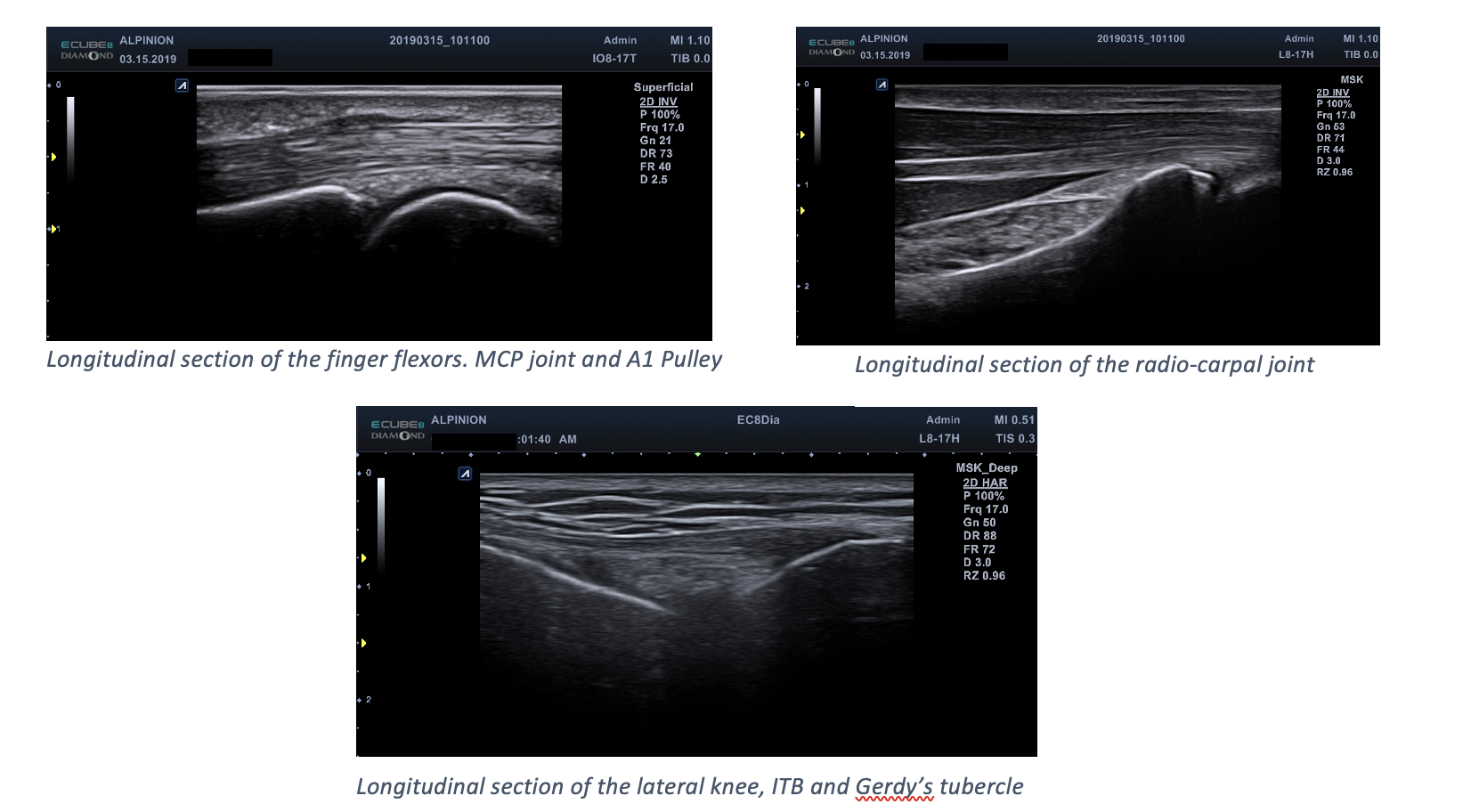
Chris Myers
There are many of brands of ultrasound systems out there so how do you know which is the right one for you? At SMUG we are partnered with GE machines and are very bias towards there products. Many of the SMUG tutors use GE machine sin their clinics and we always have a great selection of GE machines on our ultrasound courses. These vary from the lap top based, such as the “Logiq e” and “Venue Go” to the cart based machines such as the P9 and E10. The E10 is like the Ferrari of ultrasound machines. For more information about GE’s range of products watch our SMUG reviews here. At SMUG we are always getting questions about what ultrasound machines people should buy. We like to try different manufacturers and machines and have recently had the opportunity to experience the range of cart-based machines from Alpinion. Alpinion are distributed by a company called Physiquipe in the UK and Ireland. I met the Physiequipe team several years ago when I purchased a focused shockwave machine for my clinic; Complete Physio. I was very impressed with their customer service and commitment to education. They organised several free webinars and demonstrations for my team and were always on hand to support. So when they approached me about their ultrasound range I was happy to take a look, particularly as their cart based machines started at approximately £15,000! In previous blogs we have discussed many portable, lap top devices, so in this one, we are going to look at what Physiequipe can offer with their Alipinion cart-based range.
To be honest I had no idea. At SMUG we have used GE for many years and had no idea about Alpinion machines. They are a company from South Korea founded in 2007 and are totally dedicated to diagnostic ultrasound. They’re relatively new to ultrasound compared to several of the bigger brands such as GE and Canon.
They have an good range of ultrasound systems for a relatively new company. From a handheld system (minisono) a portable laptop-based system (i Cube 7) and a variety of cart-based units. I experienced their three cart-based systems:
Traditionally, I have always recommended more portable lap top machines for clinicians, as it allows you to easily move it from clinic to clinic and from room to room, but this doesn’t have to be the case. If you work in one clinic, and one clinic room a majority of the time, then you can consider a cart-based machine. Obviously, if you need to travel with your machine or work between a few clinics then you must buy a more portable, lap top based machine. The manufacturers will often suggest that image quality will be better on cart-based offering as the processer and computer wizardry is more powerful. Certainly, as a general rule, in the more established manufacturers such as GE and Canon, their cart-based machines have superior image quality to their portable lap top based machines. But this is no surprise as they are generally more expensive. We all know you get what you pay for with ultrasound machines! In previous blogs I have discussed the issues I have with handheld machines; the main one being their image quality, particularly at depth, however I also discussed how I feel they do not always “look the part”. If I was going for a scan as a patient, I would rather something that looked a little more ‘medical’. This is one advantage of the cart-based machines, they certainly “look the part” and provide the correct ‘optics’ for the patient. When a patient is expecting to have an ultrasound scan, a cart-based machine is exactly what they would expect to see (as if they were having it carried out in a radiology suite in a hospital) and maybe they take the scan more seriously. I will leave you to make up your own mind on this on. I am sure we can all agree that looking the part is very important.
I had the machines in my clinic for a minimum of 2 weeks at a time. Firstly, I have only ever had portable, lap top based machines in my clinic, so a cart-based machine was a new exciting welcome addition. Certainly, many of my patients commented on the “brand-new machine” in the room and immediately thought I had upgraded! Maybe size does matter! After trying the 8LE, 8Diamond and XC90, I was pleasantly surprised at the quality of the image for the price of these machines (we will cover price in a little bit). However, like all ultrasound machines the most expensive had the best image quality and vice-versa. No surprise there, again, you get what you pay for! Apart from the image quality, all three machines worked quite similarly i.e. the navigation of the system was simple and rather intuitive. Swapping between the probes, saving patient information, patient recall and exporting images was all very straight forward. Most standard features such as measurements, side by side comparison and colour/Power Doppler were all accessible and instinctual.
The 8LE and the 8Diamond are the most popular cart-based system from Alpinion. I am sure the price tag is one of the reasons they are very popular. The 8LE starts from £15,950 + VAT with their basic L3-12T transducer. The max. you would likely spend on this system is £19,950 + VAT with their high density L3-12H and hockey stick transducers. The 8Diamond starts at £19,950 + VAT with the high density L3-12H and up to about £25,000 + VAT with two transducer.

This may help explain how I see it. I have an iPhone ‘Light’ and my girlfriend has an iPhone ‘Pro’. To me there is no discernible difference but hers has a few extra features, but IMO it doesn’t affect not my functionality of the phone. The 8 Diamond and the 8LE are the in the same range, but one has a few more features than the other. The 8 Diamond has:
 |
 |
The XC60 & 90 are the high end machines from Alpinion range. They are both a a step up in terms of image quality from the 8LE and 8 Diamond. It may not be an GE Logiq E-10 or a Canon Aplio i800 but it certainly provides a very satisfying image. It is simple to navigate, the image quality is excellent. For 3 transducers (linear, high frequency linear, convex) the XC90 which is their highest end machine £49,950+vat – that is very competitive for the image quality and specification. 
The high frequency linear is excellent, so detailed and it isn’t in the shape of a hockey stick. This makes it way easier to handle and saves the fiddling around if doing injections around small joints. The features and navigation are self-explanatory and easy to find with no convoluted processes meaning learning how to drive the system is very quick. If you have a small clinic room/site, the XC90 is a beastiof a unit, so if you are stuck for space, probably one to avoid. The XC60 has a smaller foot print.




What are the differences between cart-based systems To sum up in one phrase – the bigger the brain the better the image.Generally, the bigger and more expensive the system, the more powerful the processing and ultimately the clearer the image.There is no real “cheat” in what you pay, or the size of the system. Generally, the more you pay, the better the image and the more features you have.I would always advise going for a new system because of the guarantees/warranty, rather than second hand/reconditioned. Second hand/reconditioned, you may have no idea how it was treated or what it was reconditioned for.For peace of mind – pay a little more!Which cart-based should I go for?Let’s assume we you have decided that a cart-based system is for you, but how do you know which one to go for? We have already established that the main things you will likely have to consider are:
The lower range cart based systems (approx.. £15,000-£25,000+vat) units is money well spent. I wouldn’t go below £15,000+vat for a cart-based. I have seen some going for less than this, but the quality isn’t there.Systems like the 8LE and 8Diamond, for their price, are a good system for the vast majority of MSK (non-radiology) clinics. The higher spec XC60 and 90 are certainly a step up and provide much better image quality.Lot’s of things to consider. If you have any questions, please do not hesitate to contact me at chris@ultrasoundtraining.co.uk